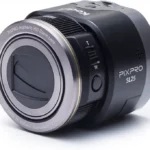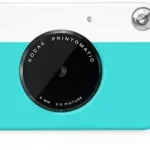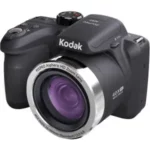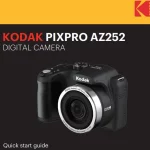

KODAK GOLD 200 Film / 3 pack / GB135-36-Vertical packaging
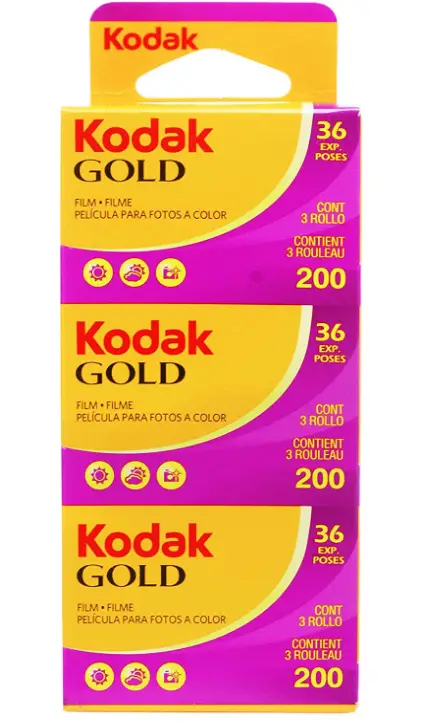
Specifications
- BRAND: KODAK,
- FILM FORMAT TYPE: 35mm,
- EXPOSURES PER ROLL: 36,
- ISO EQUIVALENT: 200,
- PACKAGE DIMENSIONS: 5.91 x 4.02 x 1.5 inches,
- ITEM WEIGHT: 3.2 ounces.
Kodak Gold has premium quality. In a 200-speed film, Kodak Gold Bright Sun & Flash 200 Film offers an excellent combination of colour saturation, colour accuracy, and sharpness. It is excellent for photographing in a variety of lighting situations. This film can also be exposed with filters under photo lamps (3400 K) or tungsten light (3200 K). The colour accuracy and saturation of Kodak Bright Sun & Flash Film are exceptional, as are the sharpness and resolution. It also has a wide exposure range of two to three stops underexposure to overexposure. It features excellent consistency and processing robustness when it comes to latent image preservation.
It’s one-channel printing has similar printing characteristics. It has high resolution and sharpness. It shows excellent results for general photography and excellent for enlargements. Kodak Royal Gold, Kodak Max, Kodak Professional Portra, and Kodak Professional Supra Films are all processed with the same chemicals. It is designed for both daylight and electronic flash exposure. It has scanning compatibility: Digital output systems produce high-quality results, and digital zoom and crop photographs produce excellent prints.
How to use
- Press down on the Rewind Knob on the left side of the camera until the rear of the camera opens.
- Cut a Leader to load your film into the Take-Up Spool. The leader must be around 22mm long to fit inside the spool.
- Place the film on the left side of the camera. Lower the Rewind Knob after inserting the film into the pocket to ensure a snug fit.
- Bring the director of the film to the Take-Up Spool. Insert the narrow end of the film leader into the slot. Hold the spool steady in one hand and force the film deep inside until it is entirely inside or emerges out the other side.
- Double-check that the teeth are properly positioned on both sides of the film. Use the rewind knob to take in any slack and secure the film to the camera. Then close the back of the camera and use the film advance to wind the film.
- Take three photos in total. If the film has been properly loaded, the rewind knob will turn every time you twist the film advance lever. If not, tighten the film to the camera once more to ensure that the slack is gone. To wipe away the exposed film and start over with new film, take at least two images. When you see the number 1 in the window, you’re ready to take pictures.
- Now is the time to select an ISO Film Speed. Gradually raise the ISO speed ring and turn it to the ISO speed specified in the window to alter the film speed. (As a result, the numbers on the ring’s INSIDE window should spin.)
- To set the shutter speed, rotate the shutter speed ring to the desired shutter speed. The shutter controls the length of exposure on this camera; the greater the number, the shorter the exposure time. (As a result, the numbers on the OUTSIDE of the ring should rotate.)
- To set the aperture, turn the aperture ring to the desired aperture. The bigger the aperture number, the less light passes through to the film, and the smaller the aperture opening.
- This camera comes with a built-in meter. When you press the shutter release button approximately a third of the way down, the meter is activated. While the meter is turned on, rotate the shutter speed dial or aperture ring until just the green o LED is lit. Your subject is too bright, as indicated by the red + LED light. To compensate, adjust the shutter speed or aperture. Your subject is too dark, as indicated by the red – LED light. Reduce the aperture or the shutter speed.
- To set a timer, press down on the self-timer lever until it stops. To start the timer, completely depress the shutter release button when you’re ready to take the image. The snapshot will be taken in ten seconds. (The timer’s length varies based on the camera’s manufacturer and kind.)
- When the roll of film is finished, you must rewind it into the canister. To rewind your film, press the film release button on the bottom of the camera. Fold the film rewind crank out of the way and turn it in the arrow’s direction until there is no more tension on the knob.
- Pull the film rewind knob up until the back cover of the camera pops open. The film should now be wrapped and ready for development in the film canister.
Frequently Asked Questions
- Is Kodak still producing 35mm film?
Despite the fact that film consumption has declined dramatically in recent decades, Kodak continues to create enormous quantities of the film in its Rochester, New York factory. - What do 36 exposures imply?
The 36EXP competition is the first dedicated to roll films. You are free to take as many photos as you want and to tell about your day, your city, one of your adventures, or what you observe on the streets. You have the option of creating a report. You are free to take images that are abstract. All genres are acceptable. - Is Portra 160 available in 35mm?
The grain structure of Kodak Portra 160 35mm film is substantially finer, allowing for better scanning and enlargement in today’s workflow. - Is film with a 400-speed rating 35mm?
It features an ISO 400/27° sensitivity and is well-suited to scanning and enlargement applications. One 24-exposure roll of 35mm film is included in this package. - Who is responsible for 35mm film development?
Processing film is straightforward at CVS Photo. You can bring any sort of film to your nearest CVS Photo facility for processing, no matter what it is. 35mm film, disposable cameras, Advanced Photo System film, black and white film, 110 film, and slide film are all processed. - Is film still used by professional photographers?
Yes, film is becoming more popular in photography. Some full-frame DSLR cameras are now more expensive than antique film cameras from a bygone era. Prices for some camera models have consistently increased by 25-50 percent year over year as more people purchase up available cameras. - Is it possible to use a 24 exposure camera to shoot a 36 exposure roll of film?
35mm film used to be available in 12, 20, 24, and 36 exposures. All of them operate perfectly in all 35mm cameras. Those exposures are usually color-coded by most camera film counters. Whatever you do, don’t force the progress when you come to the conclusion of the roll.
